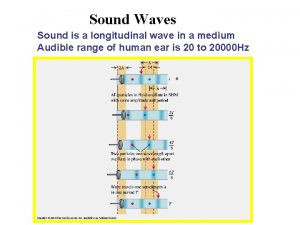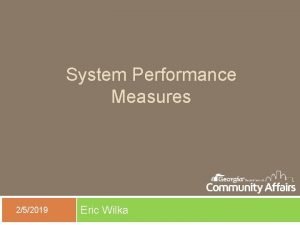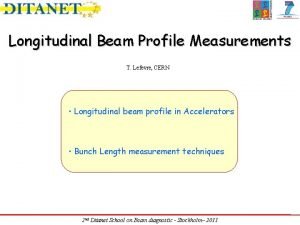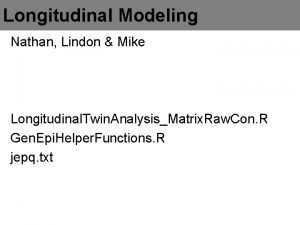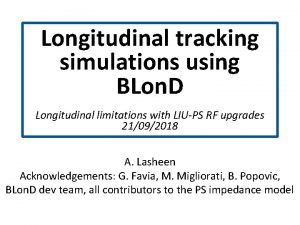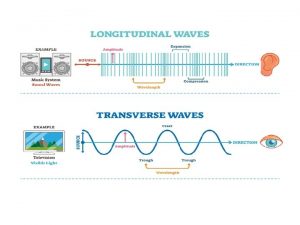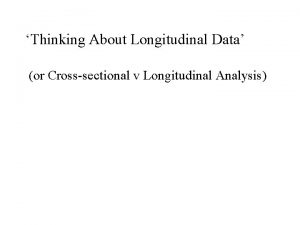Longitudinal System Analysis 252019 Eric Wilka Longitudinal System






















![Information for your Co. C What we can see after filtering [CATEGORY NAME] [PERCENTAGE] Information for your Co. C What we can see after filtering [CATEGORY NAME] [PERCENTAGE]](https://slidetodoc.com/presentation_image_h2/5acb0c7f6074ce8d22198fe7f39af6c6/image-23.jpg)




- Slides: 27

Longitudinal System Analysis 2/5/2019 Eric Wilka

Longitudinal System Analysis

Agenda Introduction of the LSA What type of data is the LSA How does your data contribute? What information your Co. C can get from the LSA

Introduction to the LSA

Introduction to the LSA 2017: Topic introduced Early 2018: Draft specifications released Summer/Fall 2018: Updates for logic revisions, new guidance, etc. for initial development q First released in September, regularly updates following Fall/Winter 2018: Community uploads Completed q More updates for fixes, new guidance, etc. Winter 2019: Review uploads, finalize updates q Working with community data liaisons (continuing)

Introduction to the LSA An export of aggregate client data generated from HMIS as part of the annual report to Congress regarding homelessness Goes into a new system: HDX 2. 0 Highly specific reporting logic to remove ambiguity and interpretation of requirements from previous reports and improve standardized community reporting across the country Export format chosen to remove any manual edit/entry process in communities

Introduction to the LSA Includes A LOT more data for HUD to analyze (almost 4 times the number of data tables/views that HUD can see now) A more “system level” look q More project types q Returns to homelessness q Longitudinal over many years New data reported to HUD q Demographics q Population groups q System use measures

Introduction to the LSA Better alignment with HMIS Data Standards HUD wants more control over how data they collect can be used and recombined for other needs q System performance analysis tool q Modeling and benchmarking system improvement activities

Data in the LSA

Data in the LSA Looks at data from a Co. C across several years Includes data from Emergency Shelters, Transitional Housing, Safe Havens, Permanent Supportive Housing and Rapid Rehousing q Time spent in projects q Clients served together in the same household Data on client characteristics q Age, Race, Ethnicity q Veteran Status q DV status (from any enrollment)

Data in the LSA Data about a household is summarized from their different project stays q Focusing on the head of household and household type q The Family of 4 served in multiple projects/project types in a year, counted once Looks at all the stays of household members where they’ve been served together for individual characteristics

Data in the LSA How households are served over different years q Household configuration q Special Subpopulations and population groups Was any client in the household ever…? q Combining time homeless from 3. 917, time in project types, time before move in q Living Situation and Exit Destination

How your data contributes

How your data contributes This looks at all projects dedicated to serving homeless persons q Funding source doesn’t matter q Every project stay is important Data Quality q Accuracy q Timeliness

How your data contributes What we would see from your agency 1 Adult, not a veteran

How your data contributes What we would see from 2 agencies Served along with another veteran at the other shelter

How your data contributes What the LSA would report out 27 days in shelter, 30 days homeless for chronic calculation, was served in the Veteran Household

Information your Co. C can get from the LSA

Information for your Co. C LSA report logic is different from any of our existing system level reports Intended to group and summarize data differently for research and reporting purposed

Information for your Co. C All of the summarized data about households are combined together so you get aggregate counts of households and individuals for different categories Example: Of the Veteran Households, how many were counted as first time homeless compared to those returning or continuously engaged?

Information for your Co. C Columns we can look at:

Information for your Co. C What we can get after filtering Total Vet Households First Time Homeless Vet Households Continuously Engaged Vet Households 179 Returning from Permanent 21 52 92 Returned Returning from Temporary 6 Returning from Unknown 8 Total Returning Vet Households 35
![Information for your Co C What we can see after filtering CATEGORY NAME PERCENTAGE Information for your Co. C What we can see after filtering [CATEGORY NAME] [PERCENTAGE]](https://slidetodoc.com/presentation_image_h2/5acb0c7f6074ce8d22198fe7f39af6c6/image-23.jpg)
Information for your Co. C What we can see after filtering [CATEGORY NAME] [PERCENTAGE] Continuously Engaged 51% [CATEG ORY NAME] [PERCENTAGE] First Time Homeless Returning Continuously Engaged

Information for your Co. C Where are veteran households served?

Population Groups

Questions?

 Test serii walda-wolfowitza
Test serii walda-wolfowitza Test u manna whitneya
Test u manna whitneya Gayle paul
Gayle paul Wide vs long format
Wide vs long format Longitudinal frame in ship
Longitudinal frame in ship Transverse frame ship
Transverse frame ship Structured analysis process
Structured analysis process Types of fact gathering in system analysis and design
Types of fact gathering in system analysis and design Organizational feasibility in system analysis and design
Organizational feasibility in system analysis and design Longitudinal study qualitative or quantitative
Longitudinal study qualitative or quantitative Draw and label a longitudinal wave
Draw and label a longitudinal wave Transverse wave vs longitudinal wave
Transverse wave vs longitudinal wave Transverse vs longitudinal waves
Transverse vs longitudinal waves Longitudinal research design example
Longitudinal research design example Keel effect airplane
Keel effect airplane Nephron structure
Nephron structure Nephron urinary system
Nephron urinary system 4 lobes of the brain
4 lobes of the brain Cross sequential study
Cross sequential study Longitudinal tensile strength
Longitudinal tensile strength Estudio descriptivo transversal
Estudio descriptivo transversal Transversal y longitudinal
Transversal y longitudinal Longitudinal vs cross sectional
Longitudinal vs cross sectional Whats a longitudinal wave
Whats a longitudinal wave The wave chapter 13
The wave chapter 13 Sound waves longitudinal waves
Sound waves longitudinal waves How sound travels
How sound travels Movimiento entrelazado soldadura
Movimiento entrelazado soldadura























